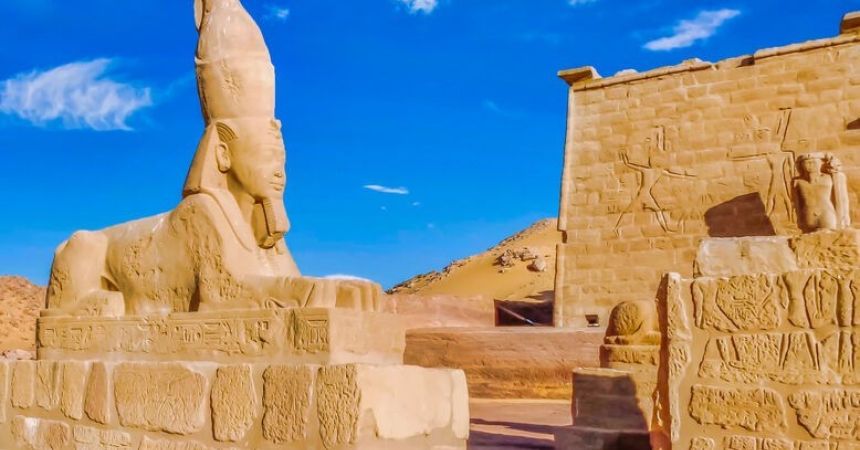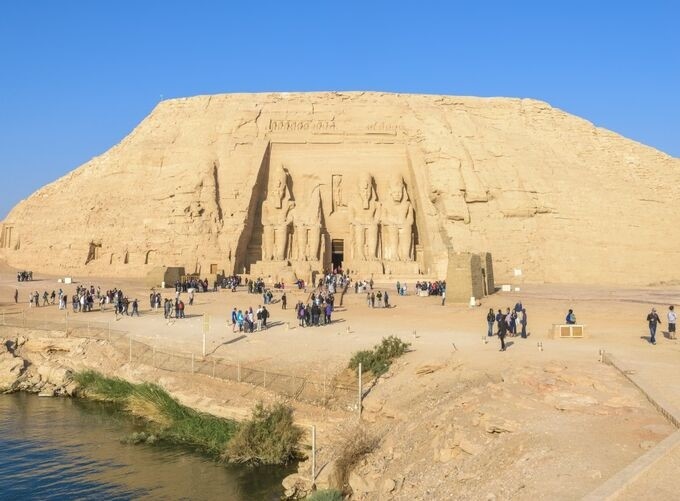
Guide to Abu Simbel – Egypt’s Architectural Marvel
Abu Simbel: The Jewel of Ancient Nubia
Abu Simbel, one of the most iconic and awe-inspiring archaeological sites in Egypt, stands as a testament to the grandeur and ambition of ancient Egyptian civilization. Nestled on the western bank of Lake Nasser, near the border with Sudan, the Visit temples of Abu Simbel are a marvel of engineering, art, and history. Built by Pharaoh Ramses II in the 13th century BCE, these temples were not only a demonstration of his divine power but also a symbol of Egypt's dominance over Nubia. This guide delves into the rich history, incredible relocation, and must-see features of Abu Simbel, providing an in-depth look at one of Egypt's most spectacular sites.
The History and Significance of Abu Simbel
1.1. Construction by Ramses II
Ramses II, also known as Ramses the Great, ruled Egypt for 66 years during the 19th Dynasty. He commissioned the construction of the Abu Simbel temples to commemorate his victory at the Battle of Kadesh and to impress upon the Nubians the might of Egypt.
- Temple of Ramses II: The larger of the two temples is dedicated to Ramses II himself, as well as the gods Ra-Horakhty, Amun, and Ptah. The facade features four colossal statues of Ramses II, each standing at over 20 meters high.
- Temple of Hathor: The smaller temple is dedicated to Hathor, the goddess of love and music, and to Ramses II's beloved wife, Queen Nefertari. The facade is adorned with six statues, four of Ramses II and two of Nefertari.
1.2. Religious and Political Symbolism
The temples of Abu Simbel were strategically located to project Egyptian power into Nubia and to protect the southern frontier of the empire. They were also intended to serve as places of worship and pilgrimage, reinforcing the divine status of Ramses II and his connection to the gods.
1.3. Rediscovery in the Modern Era
The temples were lost to the sands of time and rediscovered in 1813 by Swiss explorer Johann Ludwig Burckhardt. Four years later, Italian explorer Giovanni Belzoni managed to enter the temples, marking the beginning of their reintroduction to the world.
The Relocation of Abu Simbel
2.1. The Threat of the Aswan High Dam
In the 1960s, the construction of the Aswan High Dam posed a significant threat to Abu Simbel. The creation of Lake Nasser, one of the world's largest artificial lakes, would have submerged the temples entirely.
2.2. An International Effort
A massive international effort led by UNESCO and the Egyptian government was launched to save the temples. Between 1964 and 1968, the temples were meticulously cut into large blocks, dismantled, and reassembled on higher ground, 65 meters above their original location and 200 meters inland.
2.3. Engineering Marvel
The relocation project was a feat of modern engineering, involving the careful cutting of the temples into 1,050 blocks, each weighing between 20 and 30 tons. The blocks were then moved and reassembled with precision to preserve the original orientation and integrity of the temples.
2.4. New Site and Visitor Experience
The new site of Abu Simbel was designed to replicate the original setting as closely as possible. Visitors can now explore the temples and gain insights into both their ancient origins and the incredible relocation effort that saved them.
Exploring the Temples of Abu Simbel
3.1. The Great Temple of Ramses II
- Facade: The facade of the Great Temple is dominated by four colossal statues of Ramses II, each over 20 meters high. The statues are seated on thrones, with the pharaoh depicted wearing the double crown of Upper and Lower Egypt.
- Entrance and Hypostyle Hall: The entrance leads to a grand hypostyle hall, supported by eight massive Osirid pillars, each depicting Ramses II in the guise of Osiris, the god of the afterlife. The walls are adorned with intricate reliefs depicting the pharaoh’s military victories and divine interactions.
- Inner Sanctum: The inner sanctum houses four statues representing Ramses II, Ra-Horakhty, Amun, and Ptah. Twice a year, on February 22 and October 22, the sun aligns perfectly to illuminate the statues of Ramses II and the gods, leaving Ptah, the god of the underworld, in darkness.
3.2. The Temple of Hathor and Nefertari
- Facade: The facade of the Temple of Hathor is adorned with six statues, four of Ramses II and two of Queen Nefertari. This is one of the few instances in ancient Egyptian art where the queen is depicted at the same scale as the pharaoh.
- Hypostyle Hall: The hypostyle hall features six columns decorated with scenes of Hathor, the goddess of love, music, and motherhood. The walls depict Ramses II and Nefertari making offerings to the gods.
- Inner Sanctum: The inner sanctum is dedicated to Hathor and features a statue of the goddess with cow’s ears, symbolizing her nurturing aspect. The chamber is adorned with reliefs of Nefertari participating in rituals.

Cultural and Spiritual Significance
4.1. The Sun Festival
The biannual Sun Festival at Abu Simbel celebrates the solar alignment that illuminates the statues in the inner sanctum. This event attracts thousands of visitors who come to witness the incredible phenomenon and participate in festivities that include music, dance, and traditional Nubian performances.
4.2. Preservation of Heritage
The relocation and preservation of Abu Simbel underscore the importance of protecting cultural heritage. The site is not only a symbol of ancient Egyptian ingenuity but also of modern efforts to preserve history for future generations.
4.3. Nubian Culture
Abu Simbel is located in the region of Nubia, which has a rich and distinct cultural heritage. Visitors to Abu Simbel can also Tour to Nubian villages nearby, learning about the traditions, crafts, and daily life of the Nubian people.
Practical Information for Visitors
5.1. Getting to Abu Simbel
- By Air: The most convenient way to reach Abu Simbel is by taking a domestic flight from Cairo or Aswan to Abu Simbel Airport. The flight from Aswan takes about 30 minutes.
- By Road: Alternatively, visitors can take a bus or a private car from Aswan. The journey takes about 3-4 hours through the desert, offering a glimpse of the stark beauty of the landscape.
5.2. Best Time to Visit
The best time to visit Abu Simbel is during the cooler months from October to April. The temperatures are more comfortable for exploring the site, and the Sun Festival in February and October is a unique event to witness.
5.3. Guided Tours
Joining a guided tour is highly recommended to fully appreciate the history and significance of Abu Simbel. Knowledgeable guides provide detailed explanations of the temples' history, art, and architecture.
5.4. What to Bring
- Sun Protection: Bring sunscreen, a hat, and sunglasses to protect yourself from the intense sun.
- Comfortable Clothing: Wear lightweight, breathable clothing and comfortable shoes for walking around the site.
- Water: Carry plenty of water to stay hydrated, especially if visiting during the warmer months.
5.5. Photography Tips
- Early Morning Light: The best time for photography is early in the morning when the light is soft, and the site is less crowded.
- Respect the Rules: While photography is allowed outside the temples, check the guidelines for taking photos inside to avoid any issues.
Beyond the Temples: Exploring the Surroundings
6.1. Lake Nasser
Created by the construction of the Aswan High Dam, Lake Nasser is one of the largest artificial lakes in the world. Visitors to Abu Simbel can enjoy boat trips on the lake, fishing, and birdwatching.
6.2. Nubian Villages
Nearby Nubian villages offer a chance to experience local culture and hospitality. Visitors can explore traditional Nubian houses, enjoy home-cooked meals, and learn about the unique customs and crafts of the Nubian people.
6.3. Other Relocated Monuments
In addition to Abu Simbel, several other ancient monuments were relocated to save them from the rising waters of Lake Nasser. These include the temples of Amada, Derr, and the rock-cut temple of Beit el-Wali.
Travel to Egypt: History and Culture
Travel to Egypt, Abu Simbel is more than just a collection of ancient temples; it is a symbol of human ingenuity, both ancient and modern. The grandeur of Ramses II's vision, combined with the remarkable achievement of relocating the temples, makes Abu Simbel a must-visit destination for anyone interested in history, architecture, and culture. From the awe-inspiring statues and intricate carvings to the cultural richness of the surrounding Nubian region, Abu Simbel offers a unique and unforgettable travel experience. By visiting this remarkable site, travelers can connect with the ancient past, marvel at human achievements, and gain a deeper appreciation for the preservation of our shared heritage.



